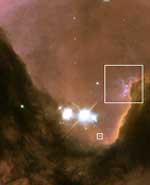
Image credit: Hubble
Three huge intersecting dark lanes of interstellar dust make the Trifid Nebula one of the most recognizable and striking star birth regions in the night sky. The dust, silhouetted against glowing gas and illuminated by starlight, cradles the bright stars at the heart of the Trifid Nebula. This nebula, also known as Messier 20 and NGC 6514, lies within our own Milky Way Galaxy about 9,000 light-years (2,700 parsecs) from Earth, in the constellation Sagittarius.
This new image from the Hubble Space Telescope offers a close-up view of the center of the Trifid Nebula, near the intersection of the dust bands, where a group of recently formed, massive, bright stars is easily visible. These stars, which astronomers classify as belonging to the hottest and bluest types of stars called type “O,” are releasing a flood of ultraviolet radiation that dramatically influences the structure and evolution of the surrounding nebula. Many astronomers studying nebulae like the Trifid are focusing their research on the ways that waves of star formation move through such regions.
The group of bright O-type stars at the center of the Trifid illuminates a dense pillar of gas and dust, seen to the right of the center of the image, producing a bright rim on the side facing the stars. At the upper left tip of this pillar, there is a complex filamentary structure. This wispy structure has a bluish color because it is made up of glowing oxygen gas that is evaporating into space.
Star formation is no longer occurring in the immediate vicinity of the conspicuous group of bright O-type stars, because their intense radiation has blown away the gas and dust from which stars are made. However, not far away there are signs of interstellar material collapsing under its own gravity, leading to ongoing star formation. One such example is a very young star that is still surrounded by a ring of gas and dust left over from the star’s formation. These circumstellar rings, called protoplanetary disks, or “proplyds” for short, are believed to be the locations where planetary systems are formed. A proplyd in the Trifid Nebula is visible near the lower right of the main Hubble image. An image enlargement of the proplyd is shown in the lower left box, where its elongated shape can be seen.
In the box at upper right, a jet of material is seen being ejected from a very young, low-mass star. The jet, extending to the lower right of the box, protrudes from the head of a dense pillar and extends three-quarters of a light-year out into the surrounding thin gas. The jet’s source is a very young stellar object that lies buried within the pillar. Previous Hubble images of the Trifid Nebula, taken in 1997, show very small, but noticeable changes in the knotty material being ejected from this jet. Accompanying the jet is a nearby stalk that points directly toward the central stars in the Trifid Nebula. This finger-like stalk is similar to the large pillars of gas in the well-known Eagle Nebula, also imaged by Hubble.
The Hubble image of the Trifid Nebula has given astronomers insight into the nature of the interaction of gaseous, dusty and stellar material in an area where dust, gas clouds, and new and old stars coexist. The science team, composed of Farhad Yusef-Zadeh (Northwestern U.), John Biretta (STScI), Bob O’Dell (Vanderbilt U.), and Mark Wardle (Macquarie U.), took exposures in filters that transmit light emitted by oxygen, hydrogen, and sulfur ions. The images were taken with the Wide Field Planetary Camera 2 onboard Hubble in mid-summer 2001 and 2002. This image was produced by the Hubble Heritage Team.
Original Source: Hubble News Release
